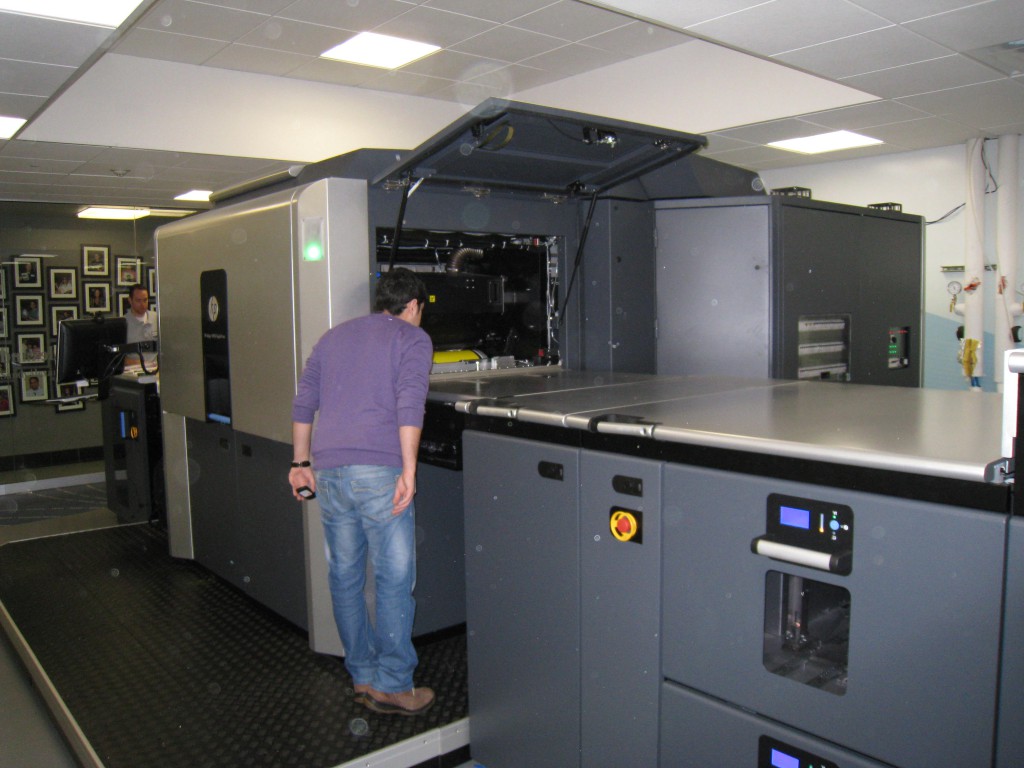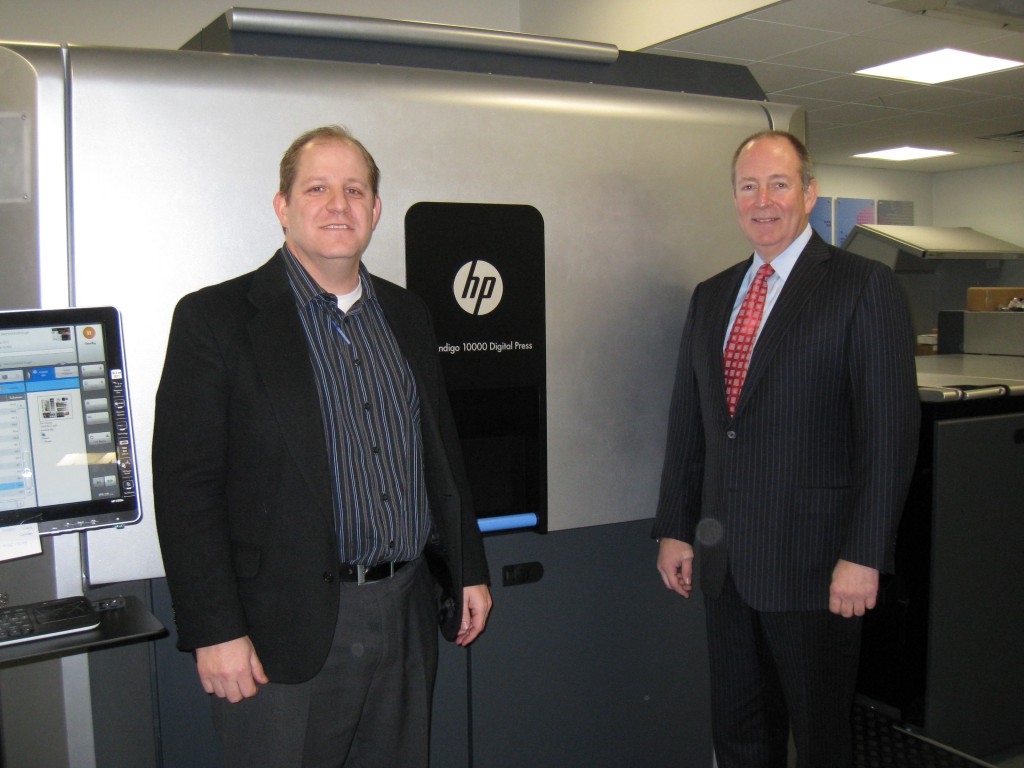At the HP Indigo 10000 in beta test at Sandy Alexander are Rob Mayerson (left), vice president and general manager, and Mike Graff, president and CEO.
B2-format digital presses were the talk of drupa, and many in the industry are still speculating about where these platforms fit into the scope of commercial print production. But, Sandy Alexander (Clifton, NJ) isn’t paying heed to the rumor mill—it’s weighing the merits of B2 digital printing for itself by beta-testing one of the most advanced examples of the technology.
The test case is an HP Indigo 10000, a 29.5″ x 20.9″ sheetfed press that HP introduced at drupa and plans to make commercially available this year. Sandy Alexander has been working with the machine since October, becoming one of four sites in the U.S. where beta testing is taking place.
The company expects to acquire the machine when testing concludes in March. If all continues to go well, a second HP Indigo 10000 may be on its way to Sandy Alexander’s digital press department as the company gears up to meet what it says is a rising demand from its customers for variable-data printing in color.
For Sandy Alexander—a full-spectrum provider of graphic communications services with a history of being first to test emerging production techniques—early adoption of digital printing in B2 format was a predictable step forward.
The company, which also offers sheetfed and web offset litho and grand-format printing, has been running digital presses for five years, settling on the HP Indigo platform as the solution that best meets its high-end quality requirements. But over time, those requirements began to outgrow the 13″ x 19″ sheet size that, until recently, represented the largest format that most sheetfed digital presses were capable of printing.
A B2 press, on the other hand, can print eight 8.5″ x 11″ pages in duplex, four to a side—a format that gives commercial printers the flexibility they need. That makes B2 the “logical layout” in variable-data digital output for the commercial market, according to Mike Graff, president and CEO of Sandy Alexander.
“It would be naïve to think that 1:1 marketing could be constrained to a four-page product,” he says. To expand into B2, Graff decided to replace a pair of existing HP Indigo 7000s with the HP Indigo 10000 he currently is testing and, depending on discussions now in progress with HP, a second installation of the machine.
One of the HP Indigo 7000s has been retired, and one remains. To help Sandy Alexander maintain digital capacity while the new B2 press comes fully online, the manufacturer has temporarily provided an HP Indigo W7200 web press that will fill any gaps in production until the second HP Indigo 10000 comes in. HP also is supporting the transition by providing an Indigo technician from the factory in Israel to monitor the testing.
Being in the vanguard of B2-format digital printing is “not for the faint of heart,” acknowledges Rob Mayerson, vice president and general manager in charge of digital operations at Sandy Alexander. Nevertheless, testing has progressed to a point where the press now is printing its first live job, a variable-data project running in batches of about 10,000 sheets per day.
Those who have seen the results are enthusiastic, and the kudos are coming not only from personnel at Sandy Alexander. “Customers would like us to be beyond beta” with the HP Indigo 10000, says Douglas Hazlett, vice president of sales and marketing. “They are lining up.”
Industrywide, most of what goes into digital production consists of static output. The HP Indigo 10000 at Sandy Alexander, however, is intended largely if not exclusively for variable-data printing. The company is so committed to reserving the device for VDP, says Mayerson, that it has installed an additional offset press—a six-color Heidelberg Speedmaster SM 52 perfector— “to take the static out of here.”
With VDP, Sandy Alexander can offer its customers printing that lets them leverage what they know about the consumers who are buying products and services from them. Print customized with 1:1 content generates response rates that static promotions can only dream about—as high as 30% in some cases, Hazlett says.
Sandy Alexander produces VDP-enhanced materials for automotive, fashion, cosmetic, and retail accounts. Clients furnish the data through a custom content management system that lets them create templated documents, update text and images, and manage their projects in real time. This channel for client input “is as important to the selling proposition as the iron,” Mayerson says.
The result is printing that drives behaviors and triggers outcomes by responding to specific consumer preferences and requests. “Hand-raisers”—expressions of interest culled from web sites and other sources—can be translated into brochures and other pieces that deliver precisely what the end-user wants to see.
Tens, hundreds, or thousands of pieces customized in this way can be printed in the same run on Sandy Alexander’s HP Indigo 10000. Thanks to the 1:1 power of VDP, says Mayerson, “we don’t send you anything that you don’t ask for”—a benefit that adds value to variable output and enables VDP producers to charge a premium for it.
 The VDP-capable HP Indigo 10000 can print in B2 format (29.5” x 20.9”) in up to seven colors at about 1,700 sph (4/4).
The VDP-capable HP Indigo 10000 can print in B2 format (29.5” x 20.9”) in up to seven colors at about 1,700 sph (4/4).
Mayerson says that the B2 platform on which this proposition rests is now running on two shifts at speeds of about 1,700 sheets per hour, 4/4, on both coated and uncoated stocks. He points out that because the B2 sheet offers more than twice the printing area of a 13” x 19” sheet, printing the larger format at the same speed increases productivity in proportion.
Like all Indigo presses, the HP Indigo 10000 is an electrophotographic device that uses a printing fluid dubbed “ElectroInk” by HP. Sandy Alexander’s press can run up seven colors of ElectroInk, including Hexachrome, spot colors, and white. For the moment, production is limited to CMYK, fully color-managed with the company’s offset and grand-format processes. The press is soon to receive a field upgrade that will enable it to handle stocks as thick as 18 pt.
A press as formidable as the HP Indigo 10000 “is not meant for someone who dabbles,” says Mayerson, who had to raise the ceiling in the digital pressroom before bringing it in. The machine is heavy enough to need a reinforced floor, and it has temperature-control requirements as well.
Although, as a half-size color press, the HP Indigo 10000 conceivably could take work away from the equipment in the company’s offset pressroom, that kind of job migration isn’t likely to occur. That objective was “very, very secondary” in the decision to install the press, says Mayerson, noting that the machine “was not purchased as a cost-saving device to replace offset.” There would have been scant ROI, he adds, in paying what the company had to pay for its HP Indigo 10000 just to gain a little production efficiency.
Besides, the two processes can be teamed profitably in projects like the car owner’s information kit that Sandy Alexander produces for one of its automotive customers. Here, the mailing envelope and the portfolio enclosure are printed on litho equipment. Digital printing customizes the diecut, tabbed, and wire-bound booklet inside the portfolio.
The company’s advance into B2 digital production is in keeping with its policy of making continuous technical progress on multiple fronts. Among its other innovations, Sandy Alexander was one of the first printers to use gray balance as a technique for controlling color on press. It also served as a beta test site for GRACoL G7 certification, and it was the first printer in the East to install an eight-unit litho press.
“If you stand still, you are guaranteed not to succeed,” says Graff. Pioneering new methods of solving problems for Sandy Alexander’s customers is “just the fabric of the company,” he says.


